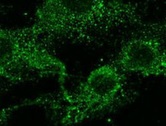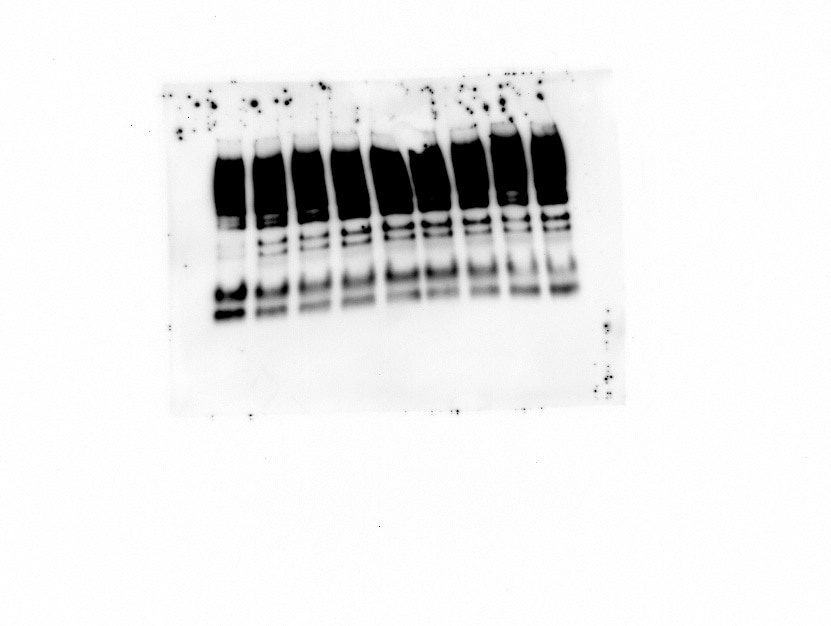Human Serpin A1/ alpha 1-Antitrypsin Antibody Summary
Glu25-Lys418
Accession # P01009
Applications
Please Note: Optimal dilutions should be determined by each laboratory for each application. General Protocols are available in the Technical Information section on our website.
Scientific Data
 View Larger
View Larger
Detection of Human Serpin A1/ alpha 1‑Antitrypsin by Western Blot. Western blot shows human plasma and lysates of human lung tissue and human kidney tissue. PVDF membrane was probed with 1 µg/mL of Mouse Anti-Human Serpin A1/a1-Antitrypsin Monoclonal Antibody (Catalog # MAB1268) followed by HRP-conjugated Anti-Mouse IgG Secondary Antibody (HAF018). Specific bands were detected for Serpin A1/a1-Antitrypsin at approximately 50-60 kDa (as indicated). This experiment was conducted under reducing conditions and using Immunoblot Buffer Group 1.
 View Larger
View Larger
Serpin A1/ alpha 1‑Antitrypsin in HepG2 Human Cell Line. Serpin A1/a1-Antitrypsin was detected in immersion fixed HepG2 human hepatocellular carcinoma cell line using Mouse Anti-Human Serpin A1/ a1-Antitrypsin Monoclonal Antibody (Catalog # MAB1268) at 10 µg/mL for 3 hours at room temperature. Cells were stained using the NorthernLights™ 557-conjugated Anti-Mouse IgG Secondary Antibody (red; NL007) and counter-stained with DAPI (blue). Specific staining was localized to cytoplasm. View our protocol for Fluorescent ICC Staining of Cells on Coverslips.
 View Larger
View Larger
Detection of Human Serpin A1/ alpha 1‑Antitrypsin by Simple WesternTM. Simple Western lane view shows lysates of human plasma, loaded at 0.2 mg/mL. A specific band was detected for Serpin A1/ alpha 1‑Antitrypsin at approximately 65 kDa (as indicated) using 10 µg/mL of Mouse Anti-Human Serpin A1/ alpha 1‑Antitrypsin Monoclonal Antibody (Catalog # MAB1268). This experiment was conducted under reducing conditions and using the 12-230 kDa separation system.
 View Larger
View Larger
Detection of Serpin A1/ alpha 1‑Antitrypsin in Human Prostate. Serpin A1/ alpha 1‑Antitrypsin was detected in immersion fixed paraffin-embedded sections of Human Prostate using Mouse Anti-Human Serpin A1/ alpha 1‑Antitrypsin Monoclonal Antibody (Catalog # MAB1268) at 5 µg/mL for 1 hour at room temperature followed by incubation with the Anti-Mouse IgG VisUCyte™ HRP Polymer Antibody (Catalog # VC001). Before incubation with the primary antibody, tissue was subjected to heat-induced epitope retrieval using VisUCyte Antigen Retrieval Reagent-Basic (Catalog # VCTS021). Tissue was stained using DAB (brown) and counterstained with hematoxylin (blue). Specific staining was localized to cytoplasm in epithelial cells. View our protocol for IHC Staining with VisUCyte HRP Polymer Detection Reagents.
Reconstitution Calculator
Preparation and Storage
- 12 months from date of receipt, -20 to -70 °C as supplied.
- 1 month, 2 to 8 °C under sterile conditions after reconstitution.
- 6 months, -20 to -70 °C under sterile conditions after reconstitution.
Background: Serpin A1/alpha 1-Antitrypsin
Serpin A1 is the archetypal member of the Serpin superfamily of the serine protease inhibitors (1). As one of the most abundant proteinase inhibitors in the circulation, it is synthesized in the liver and secreted into the bloodstream with the major function to protect tissues against neutrophil elastase. A severe Serpin A1 deficiency leads to several clinical complications such as pulmonary emphysema, juvenile hepatitis, cirrhosis, and hepatocellular carcinoma (2). The deficiency is caused by point mutations in naturally occurring Serpin A1 variants (over 70 are known). For example, the Z variant (Glu342 to Lys) forms intracellular inclusion bodies, is not secreted, and leads to a severe Serpin A1 deficiency (3).
- Silverman, G.A. et al. (2001) J. Biol. Chem. 276:33293.
- Barbour, K.W. et al. (2002) Genomics 80:515.
- Lomas, D.A. et al. (2002) Biochem. Soc. Trans. 30:89.
Product Datasheets
Citations for Human Serpin A1/ alpha 1-Antitrypsin Antibody
R&D Systems personnel manually curate a database that contains references using R&D Systems products. The data collected includes not only links to publications in PubMed, but also provides information about sample types, species, and experimental conditions.
13
Citations: Showing 1 - 10
Filter your results:
Filter by:
-
Cyanuric chloride as the basis for compositionally diverse lipids†
Authors: David Nardo, Caleb M. Akers, Nicholas E. Cheung, Cierra M. Isom, Jason T. Spaude, Daniel W. Pack et al.
RSC Advances
-
In vitro Differentiation of TERT-Transfected Multi-Lineage Progenitor Cells (MLPC) into Immortalized Hepatocyte-Like Cells
Authors: Collins D, Hapke J, Aravalli R, Steer C
HMER
-
Serum alpha-1 Antitrypsin (AAT) antagonizes intrinsic apoptosis induction in neutrophils from patients with systemic inflammatory response syndrome.
Authors: Sarabhai Theresia, Peter Christoph, Bar Anne-Kathrin et al.
PloS One
-
SARS-CoV-2 infection induces beta cell transdifferentiation
Authors: Tang X, Uhl S, Zhang T et al.
Cell Metabolism
-
Specific Cerebrospinal Fluid SerpinA1 Isoform Pattern in Alzheimer’s Disease
Authors: Lorenzo Barba, Steffen Halbgebauer, Federico Paolini Paoletti, Giovanni Bellomo, Samir Abu-Rumeileh, Petra Steinacker et al.
International Journal of Molecular Sciences
-
Phenotypical, functional and transcriptomic comparison of two modified methods of hepatocyte differentiation from human induced pluripotent stem cells
Authors: Rong Li, Yang Zhao, Jeffrey J. Yourick, Robert L. Sprando, Xiugong Gao
Biomedical Reports
-
Protease-anti-protease compartmentalization in SARS-CoV-2 ARDS: Therapeutic implications
Authors: OF McElvaney, T Asakura, SL Meinig, JL Torres-Cas, RS Hagan, C Gabillard, MP Murphy, LB Thorne, A Borczuk, EP Reeves, RE Zumwalt, Y Mikami, TP Carroll, K Okuda, G Hogan, OJ McElvaney, J Clarke, NL McEvoy, PW Mallon, C McCarthy, G Curley, MC Wolfgang, RC Boucher, NG McElvaney
EBioMedicine, 2022-02-22;77(0):103894.
Species: Human
Sample Types: Plasma
Applications: Immunoprecipitation -
Fecal host biomarkers predicting severity of Clostridioides difficile infection
Authors: M Golizeh, K Winter, L Roussel, M Landekic, M Langelier, VG Loo, M Ndao, DC Vinh
JCI Insight, 2021-01-11;0(0):.
Species: Human
Sample Types: Protein
Applications: Western Blot -
Hepatic Differentiation of Marmoset Embryonic Stem Cells and Functional Characterization of ESC-Derived Hepatocyte-Like Cells
Authors: Rajagopal N Aravalli, Daniel P Collins, Joel H Hapke, Andrew T Crane, Clifford J Steer
Hepatic Medicine: Evidence and Research
-
CSF SerpinA1 in Creutzfeldt–Jakob disease and frontotemporal lobar degeneration
Authors: Samir Abu‐Rumeileh, Steffen Halbgebauer, Petra Steinacker, Sarah Anderl‐Straub, Barbara Polischi, Albert C. Ludolph et al.
Annals of Clinical and Translational Neurology
Applications: Simple Western -
Modified serpinA1 as risk marker for Parkinson's disease dementia: Analysis of baseline data
Sci Rep, 2016-05-17;6(0):26145.
Species: Human
Sample Types: CSF
Applications: Western Blot -
Differential Sialylation of Serpin A1 in the Early Diagnosis of Parkinson’s Disease Dementia
Authors: Sarah Jesse, Stefan Lehnert, Olaf Jahn, Lucilla Parnetti, Hilkka Soininen, Sanna-Kaisa Herukka et al.
PLoS ONE
-
Maggot chymotrypsin I from Lucilia sericata is resistant to endogenous wound protease inhibitors.
Authors: Telford G, Brown AP, Kind A, English JS, Pritchard DI
Br. J. Dermatol., 2010-11-29;164(1):192-6.
Species: Human
Sample Types: Tissue Homogenates
Applications: Western Blot
FAQs
No product specific FAQs exist for this product, however you may
View all Antibody FAQsReviews for Human Serpin A1/ alpha 1-Antitrypsin Antibody
Average Rating: 4.8 (Based on 4 Reviews)
Have you used Human Serpin A1/ alpha 1-Antitrypsin Antibody?
Submit a review and receive an Amazon gift card.
$25/€18/£15/$25CAN/¥75 Yuan/¥2500 Yen for a review with an image
$10/€7/£6/$10 CAD/¥70 Yuan/¥1110 Yen for a review without an image
Filter by:



